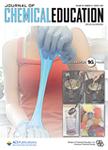版权所有:内蒙古大学图书馆 技术提供:维普资讯• 智图
内蒙古自治区呼和浩特市赛罕区大学西街235号 邮编: 010021

作者机构:Curtin Univ Dept Chem Nanochem Res Inst GPO Box U1987 Perth WA 6845 Australia
出 版 物:《JOURNAL OF CHEMICAL EDUCATION》 (化学教育杂志)
年 卷 期:2016年第93卷第3期
页 面:542-549页
核心收录:
学科分类:0401[教育学-教育学] 07[理学] 0703[理学-化学]
主 题:Continuing Education Graduate Education/Research Internet/Web-Based Learning Chemoinformatics Crystals/Crystallography Enrichment/Review Materials X-ray Crystallography Solids
摘 要:Crystallographic information provides the fundamental basis for understanding the properties and behavior of materials. This data, such as chemical composition, unit cell dimensions, space group, and atomic positions, derives from the primary literature that is, from published experimental measurement or theoretical calculation. Although the major crystallographic journals provide their published data in the form of computer-readable *.cif text files, finding and accessing this material directly is often difficult and certainly time-consuming. On the other hand, we are fortunate to have ready access through the Internet to extensive crystallographic databases, both academic/commercial and free, where the former databases are critically compiled and of the highest quality. The available databases generally specialize, as for inorganic or organic materials, or minerals, etc. The current paper is directed at the occasional user of crystallographic information, and examines methods of searching for and obtaining crystallographic information (mainly inorganic and minerals, but also organic, biological and metallic) from some important free databases;namely: NIMS AtomWorks for inorganics;the Crystallography Open Database (COD) for both inorganics and organics;WWW-Mincryst for minerals;the Protein Databank (PDB) for proteins and nucleic acids;and the Database of Zeolite Structures. An example of a search repeatedly used here demonstrates the changes in information provided from the first X-ray structural determination (of halite by the father-and-son Braggs) to modern representations. The professional researcher is best served by the academic/commercial databases: Inorganic Crystal Structure Database (ICSD);Cambridge Structure Database (CSD) for organics;Pearson s Crystal Data (PCD) for inorganics;Crystmet for metallic systems, etc. However, free demonstration versions of these important databases provide user introductions and, indeed, usable data for a limited range of m